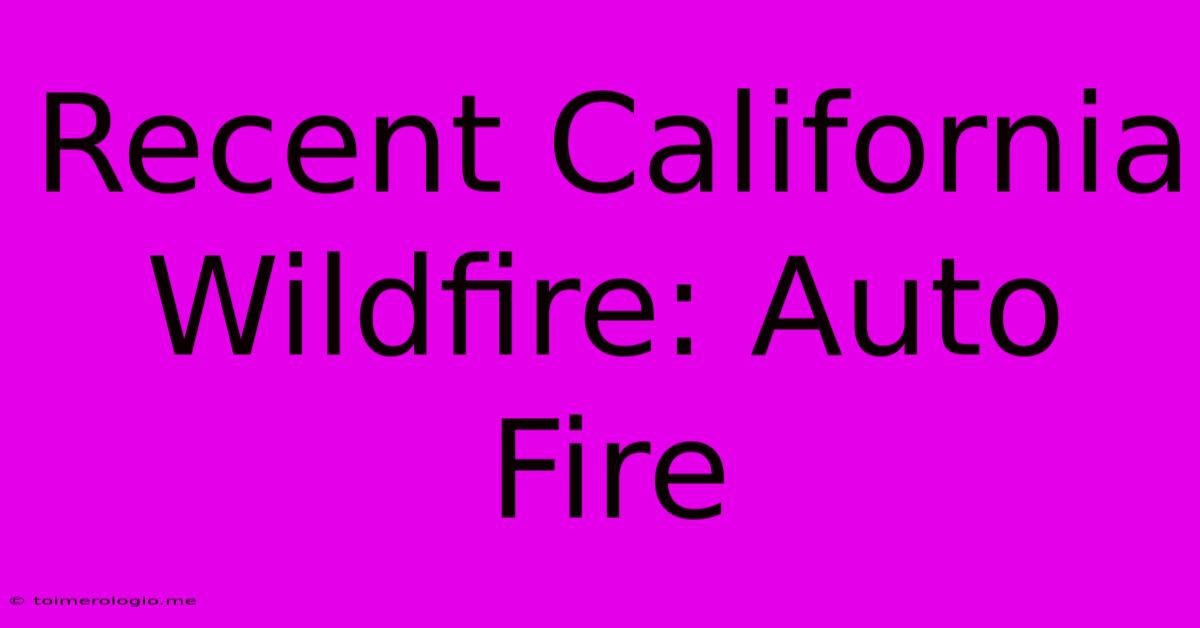Recent California Wildfire: Auto Fire

Discover more detailed and exciting information on our website. Click the link below to start your adventure: Visit Best Website toimerologio.me. Don't miss out!
Table of Contents
Recent California Wildfires: The Growing Threat of Auto Fires
California's wildfire season is notorious, a period of intense heat, dry brush, and devastating blazes. But in recent years, a concerning trend has emerged: the significant contribution of auto fires to these catastrophic events. This isn't just about cars spontaneously combusting; it's a complex issue involving malfunctioning vehicles, roadside debris, and the increasingly flammable landscape itself. Understanding this growing threat is crucial for mitigating future risks and protecting lives and property.
The Role of Auto Fires in California Wildfires
While lightning strikes and human negligence remain primary causes of California wildfires, the role of auto fires is steadily increasing. These incidents can act as ignition points, sparking infernos in already parched conditions. Several factors contribute to this escalating problem:
1. Increased Vehicle Density and Usage:
California's vast network of highways and roads sees immense traffic, particularly during peak seasons. More vehicles on the road statistically increase the probability of mechanical failures, accidents, and consequently, fires. Increased tourism and population density further exacerbate this risk.
2. Aging Vehicle Fleets and Inadequate Maintenance:
Many vehicles on California roads are older models with potentially faulty electrical systems or aging fuel lines. Lack of regular maintenance and timely repairs increases the likelihood of mechanical failures that can lead to fires. This is particularly concerning given the state's diverse terrain, where breakdown assistance may be delayed.
3. Hot Exhaust Systems and Dry Vegetation:
Hot exhaust systems can easily ignite dry grass and brush lining roadsides. This is especially dangerous during periods of extreme drought when vegetation becomes incredibly flammable. Even a small spark can quickly escalate into a large wildfire, particularly with strong winds.
4. Roadside Debris and Flammable Materials:
Accumulated roadside debris, including dry grass, leaves, and discarded materials, acts as readily available fuel for any ignition source, including auto fires. This debris enhances the spread of fires and makes containment more challenging.
Types of Auto Fires and Their Wildfire Impact
Auto fires contributing to wildfires aren't a single, uniform phenomenon. The cause and impact vary considerably:
1. Mechanical Failures:
These fires often originate from electrical shorts, fuel leaks, or overheating engine components. The ensuing blaze can rapidly spread to surrounding vegetation, particularly in areas with dense brush or dry grasses near roadways. These are often difficult to predict and prevent entirely.
2. Accidents and Collisions:
Vehicle collisions can result in fires, especially when fuel tanks are ruptured or electrical systems are damaged. The impact force and subsequent fire can quickly engulf nearby vegetation, transforming a traffic accident into a wildfire ignition source.
3. Arson:
While less common, intentional vehicle arson can also contribute to wildfires. These incidents often involve malicious intent and can be particularly devastating given the potential for rapid fire spread.
Mitigating the Risk of Auto Fires and Their Impact on Wildfires
Addressing the increasing threat of auto fires requires a multi-pronged approach focusing on prevention, early detection, and rapid response:
1. Vehicle Maintenance and Safety Checks:
Regular vehicle maintenance, including inspections of electrical systems, fuel lines, and brakes, is essential. Drivers should be aware of potential warning signs of mechanical issues and promptly address any problems. Promoting regular vehicle servicing through public awareness campaigns can help prevent many auto fires.
2. Improved Roadside Management:
Regular clearing of roadside vegetation and debris significantly reduces the amount of readily available fuel for fires. Controlled burns in designated areas can also help manage vegetation density and reduce fire risk. Implementing stricter regulations on littering and dumping near roadsides is also crucial.
3. Enhanced Emergency Response Systems:
Improving early detection systems through technology like roadside sensors and advanced fire spotting techniques is vital. Rapid response times are essential for containing auto-ignited wildfires before they escalate into larger, uncontrollable blazes. Investing in better fire-fighting infrastructure and training for firefighters is a non-negotiable requirement.
4. Public Awareness Campaigns:
Educating the public on the risks of auto fires and their contribution to larger wildfires is vital. Simple actions like ensuring proper vehicle maintenance and avoiding roadside littering can make a substantial difference. Campaigns emphasizing responsible driving habits and preparedness in wildfire-prone areas are essential.
5. Technological Advancements:
Exploring technological solutions, such as advanced fire suppression systems in vehicles or early warning systems for potential mechanical failures, could offer further protection. Research into fire-resistant materials for vehicles and roadside infrastructure could significantly reduce the spread of wildfires.
Conclusion: A Collaborative Effort is Needed
The growing contribution of auto fires to California's wildfire crisis demands a concerted effort from individuals, the automotive industry, and government agencies. By implementing preventative measures, improving emergency response systems, and raising public awareness, we can significantly mitigate this escalating threat. This is not solely about protecting property; it's about preserving lives and safeguarding the precious natural resources of California. The future of California's landscape depends on our collective action to address this increasingly significant challenge. Ignoring this problem will only lead to more devastation in years to come. A proactive, multi-faceted approach is crucial to ensure the safety and well-being of California's communities and its environment.

Thank you for visiting our website wich cover about Recent California Wildfire: Auto Fire. We hope the information provided has been useful to you. Feel free to contact us if you have any questions or need further assistance. See you next time and dont miss to bookmark.
Also read the following articles
| Article Title | Date |
|---|---|
| Inside Jessica Simpson And Eric Johnsons Marriage | Jan 16, 2025 |
| Steve Kerrs Warning To The Warriors | Jan 16, 2025 |
| Ventura County Fire Update 56 Acres Burned | Jan 16, 2025 |
| Jessica Simpson And Eric Johnsons Marriage Status | Jan 16, 2025 |
| Mortgage Or Future Warriors Dilemma | Jan 16, 2025 |
